Course:FNH200/Assignments/2022/Canada Dry ginger ale Regular vs Diet
Introduction
Canada Dry is a brand founded by John J. McLaughlin in 1904 that produces soft drinks[1][2]. Canada Dry ginger ale is one of Canada Dry's products which is very popular. A lot of people enjoy drinking it. However, it contains a large amount of sugar[3]. Many people seek a zero-sugar alternative. That is why Canada Dry ginger ale Diet was invented. In this page, we compared the difference of ingredients between Canada Dry ginger ale and Canada Dry ginger ale Diet, especially focusing on the sweeteners.
Post pictures
| Canada Dry Ginger Ale - Regular | Canada Dry Ginger Ale - Diet |
|---|---|
 |
 |
 |
 |
Ingredient lists
| Ingredients list | |
|---|---|
| Canada Dry ginger ale Diet | Carbonated water, Citric acid, Sodium Citrate, Sodium Benzoate, Malic acid, Aspartame (82 mg / 355 mL Contains Phenylalanine), Natural flavour, Colour, Acesulfame Potassium (34 mg / 355 mL), Calcium Disodium EDTA. |
| Canada Dry ginger ale Regular | Carbonated water, Sugar/Glucose-Fructose, Citric Acid, Sodium Benzoate, Colour, Natural flavour. |
| Canada Dry Ginger Ale - Diet | Canada Dry Ginger Ale - Regular | |
|---|---|---|
| Fat substitutes | None | None |
| Sugar substitutes | Acesulfame Potassium
Aspartame |
None |
| Additives | Acesulfame Potassium
Aspartame Citric acid Sodium Citrate Sodium Benzoate Malic acid Colour Calcium Disodium EDTA |
Citric acid
Sodium Benzoate Colour |
3. Explain the roles of fat substitutes, sugar substitutes, and/or additives used in terms of the functional properties they contribute to the product
Sugar Substitutes
- Aspartame – The main functional property of Aspartame is to impart sweetness. It is a sweetener that is about 180-220 times sweeter than sucrose (table sugar) with a similar amount of calories per unit of mass and can therefore be used in significantly smaller amounts to achieve the same amount of sweetness as sucrose while achieving a very low calorie amount.
- Acesulfame Potassium – The main functional property of Acesulfame Potassium is to impart sweetness. It is a sweetener that is about 200 times sweeter than sucrose (table sugar). It does not get metabolized by the body, so it contributes 0 calories. Also, Acesulfame potassium does not contribute towards tooth decay, as it is not fermented by oral bacteria.
Additives
- Citric acid – The functional properties of citric acid are to impart flavour and act as a preservative. It is also important to mention, citric acid is responsible for the bubbly sensation in soda drinks such as Canada Dry ginger ale.[5]
- Sodium Benzoate – The functional property of sodium benzoate is to act as a preservative and prevent spoilage. It also contributes to the acidic flavor of soda drinks such as Canada Dry ginger ale.[6]
- Color – The main functional property of color is to impart a color in the drink.
- Sodium Citrate – The functional properties of are to act as a preservative and impart a sour salt flavor.[7]
- Malic acid – The main functional property of malic acid is to impart flavor. It also intensifies fruit flavor and adds a tart taste.[8]
- Calcium Disodium EDTA – The functional properties of Calcium Disodium EDTA are to act as a preservative and prevent the loss of flavor.[9]
4. Compare and contrast the lists of the two products and explain differences
Carbonated water, citric acid, sodium benzoate, color and natural flavor appear in both Canada Dry ginger ale Diet and Canada Dry ginger ale Regular. Among these ingredients, carbonated water, a kind of water containing CO2, is the reason why these two drinks are called pop[10]. Another important ingredient is natural flavor, which contributes to the taste of ginger since it includes real ginger flavour[3].
There are also differences in the ingredients between these two drinks. Canada Dry ginger ale Regular contains sugar/glucose-fructose exclusively. Glucose has a sweetness index of 0.74-0.8 (Sucrose is 1) [11]. Fructose has a sweetness index of 1.17-1.75[11]. From the data, we can see that fructose is much sweeter than glucose. However, it could not be concluded that fructose contributes more sweetness than glucose since we do not know the content of these two kinds of sugar. A reasonable guess of the source of these two kinds of sugar is invert sugar[12]. Invert sugar has mature technology to be commercially prepared so it is widely used in sweetened beverages[13]. Glucose and fructose contribute to the 130 Calories of energy in Canada Dry ginger ale Regular[3]. Energy is important for people's daily life. However, consuming too much sugar might also cause obesity[14]. So Canada Dry ginger ale Regular may not be an ideal product for those dieting, as well as for people who are diabetic and looking to decrease their sugar intake.
Canada Dry ginger ale Diet exclusively contains sodium citrate, malic acid, aspartame (82mg / 355ml contains phenylalanine), acesulfame potassium (34mg / 355ml), calcium disodium EDTA. Since there is no sugar in the product, aspartame and acesulfame potassium are added to provide sweetness. Aspartame and acesulfame potassium have indexes of 180-250 and 200 respectively[11], which means strong sweetness can be provided with little amount of them. The reason why phenylalanine is listed separately is that people who have phenylketonuria can not metabolize phenylalanine[15]. Consuming phenylalanine may cause severe problems for them[16]. Therefore, listing phenylalanine in the ingredients list, can prevent those with phenylketonuria from consuming it. The reason why malic acid, sodium citrate and calcium disodium EDTA are added is because sugar is substituted by artificial sweeteners, therefore the flavor of Canada Dry ginger ale Diet might slightly change from the regular drink. Those additives are added to adjust the flavor to be like the Regular one as much as possible[9] [17][18]. Last but not least, it is worth mentioning that aspartame does contain energy. However, since the content of it is too little to be considered a calorie, the energy it provides is ignored[19]. So for people who care about decreasing energy consumption, Canada Dry ginger ale Diet is an ideal choice.
Labels
- A detailed description of the information found on the labels: The Labels found on both the products follow through with the requirements based on the Consumer Packaging and Labelling Act and Regulations[20] that are laid out according to the Canadian Food Inspection Agency (CFIA)[21]
| Label Information | |||
|---|---|---|---|
| Label | Description | Canada Dry Ginger Ale - Regular: Images | Canada Dry Ginger Ale - Diet: Images |
| Nutrition Facts Table | The label lists the following details about the product:
|
 |
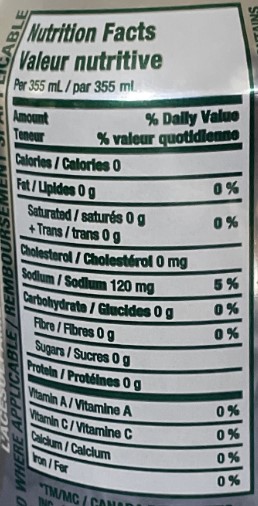 |
| Common Name | The label describes the Common Name of the product. | 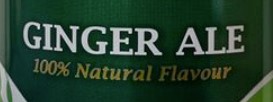 |
 |
| Net Quantity | The label contains information about the serving size of the product. |  |
 |
| Calories Per Can | The label contains the calorie intake per can. |  | |
| Brand Logo:
[Identity] |
The label displays the product company's logo. |  |
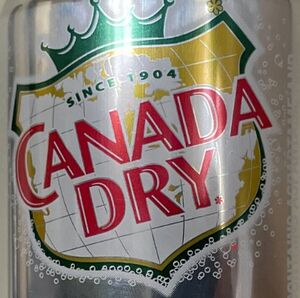 |
| Brand Website:
[Identity] |
The label displays the brand's website. |  |
Unavailable on the Can |
| Company Phone Number:
[Identity] |
The label displays the brand's contact number. |  |
 |
| Factory Address:
[Principal Place of Business] [Location] |
The label displays the brand's headquarters address. |  |
 |
| Ingredients:
[List of Ingredients] |
The label provides information on the ingredients used in
the manufacturing of the product |
 |
 |
| Sweeteners | This information is available in the list of ingredients | Sugar/Glucose-Fructose | Aspartame (82 mg/ 355 mL)
Acesulfame Potassium (34 mg / 355 mL) |
| Item Barcode:
[Legibility] |
The label displays the item bar code that the retailer and
the production company can use to keep track of inventory. |
 |
 |
| Item Serial Code:
[Legibility] |
The label contains a unique identification serial code for
the particular product. |
 | |
| Recycling Information | The label displays the Recycling Information of the can. |  |
 |
| Bilingual Information | The label shows how all the information presented on the can are
translated into the official languages on Canada English AND French |
 |
 |
| Crown Holdings Logo:
[Legibility] |
The logo shows the company responsible for the manufacturing of
the cans - Crown Holdings |
 |
 |
| Durable Life | There is no expiration date on either of the products, however
there is a manufacturing date printed on the bottom of both cans. |
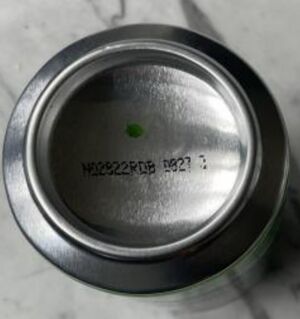 |
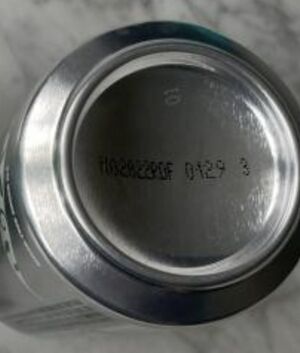 |
- Indicate whether the information complies with the regulatory requirements as outlined in Lesson 04. --- First of all, both Canada Ginger Ale Regular and diet do not contain any false, misleading or deceptive information.[22] They clearly labeled all the ingredients on the can. No word mentions about being a treatment or preventative or cure for any diseases, disorder or abnormal physical states. There is no drug in both of the products. They also clearly label the amount of Acesulfame Potassium and Aspartame, which are sweeteners, inside the ingredient list which is the law.[22] [23] They also have the detailed origin. [24] Because the product is in a can, it will be stored under sanitary conditions. [24] Lastly, the net quantity of the food is also clearly labeled.
Personal Choice
Personal choices are submitted on Canvas.
References
- ↑ "The Canada Dry Story". Canada Dry. Retrieved July 15, 2022.
- ↑ 2.0 2.1 "Canada Dry Products". Canada Dry. Retrieved July 15, 2022.
- ↑ 3.0 3.1 3.2 "Canada Dry Ginger Ale". Canada Dry. Retrieved July 16, 2022.
- ↑ "Lists of Permitted Food Additives". Canada.ca. 15 July, 2022. Check date values in:
|date=(help) - ↑ "What Is Citric Acid, and Is It Bad for You?". Retrieved July 16, 2022.
- ↑ "What Is Sodium Benzoate? Everything You Need to Know". Retrieved July 16, 2022.
- ↑ "What is Sodium Citrate (E331) in food? Types, Uses and Safety". Retrieved July 19, 2022.
- ↑ "Malic Acid: Your Key to Smoother, Younger Skin". Retrieved July 19, 2022.
- ↑ 9.0 9.1 "Is Calcium Disodium EDTA a Safe Additive". healthline. Retrieved July 17, 2022.
- ↑ "Carbonated (Sparkling) Water: Good or Bad?". healthline. Retrieved July 18, 2022.
- ↑ 11.0 11.1 11.2 "Sweetness". Wikipedia. Retrieved July 16, 2022.
- ↑ "Invert Sugar Facts and Benefits". verywellfit. Retrieved July 18, 2022.
- ↑ "Inverted sugar syrup". Wikipedia. Retrieved July 16, 2022.
- ↑ "Sugars and Obesity". Action on Sugar. Retrieved July 18, 2022.
- ↑ "Phenylketonuria". MedlinePlus. Retrieved July 18, 2022.
- ↑ "Phenylketonuria". Wikipedia. Retrieved July 17, 2022.
- ↑ "Sodium Citrate". the chemical company. Retrieved July 19, 2022.
- ↑ "Malic acid". Wikipedia. Retrieved July 17, 2022.
- ↑ "All About Aspartame". Food Insight. Retrieved July 19, 2022.
- ↑ "Consumer Packaging and Labelling Act and Regulations". Wikipedia. Retrieved Retrieved Jul 19, 2022. line feed character in
|title=at position 37 (help); Check date values in:|access-date=(help) - ↑ "Canadian Food Inspection Agency". Government of Canada. Retrieved Retrieved Jul 19, 2022. Check date values in:
|access-date=(help) - ↑ 22.0 22.1 "General principles for labelling and advertising". Retrieved 2022.7.18. Check date values in:
|access-date=(help) - ↑ M.B.A., Glória (2003). "ASPARTAME". Encyclopedia of Food Sciences and Nutrition (Second Edition): 332–338.
- ↑ 24.0 24.1 "Foods, Drugs, Cosmetics and Devices (continued) General (continued)". Justice Laws Website. 1985. Retrieved 2022.7.18. line feed character in
|title=at position 48 (help); Check date values in:|access-date=(help)
| This Food Science resource was created by Course:FNH200. |


